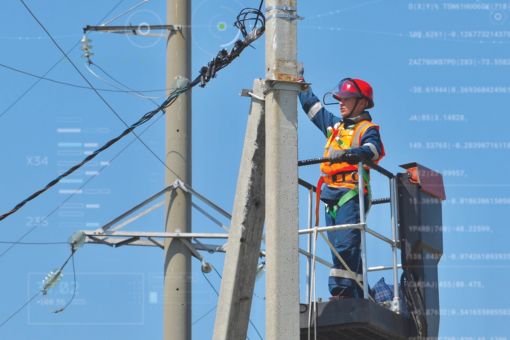For many buyers, preparing to make a significant investment means making sure it’s the right fit. Whether it’s test-driving a car, touring a home, or trying on a pair of shoes—there’s peace of mind in knowing what you’re getting. So why should a business investment be any different? When businesses leverage the right technology, they can help customers better visualize solutions before making a purchase—saving time and money for all.
Leveraging past experience leads to accelerated growth
Manufacturers today face mounting pressures to keep up with rapidly changing customer needs. With time in short supply, sometimes the best way to keep up with change is to leverage the momentum you’ve already gained. One company that successfully scaled its business operations by iterating and improving upon past work—and investing in new technologies—is Hitachi Energy.
Hitachi Energy is a global leader providing product, system, software, and service solutions across the power chain. Through their advanced portfolio of sustainable, digital energy solutions, they work with partners spanning the energy, industry, mobility, IT, and civic sectors.
Highly customized solutions come at a cost to manufacturers
Hitachi Energy knows the value of an efficient grid. A drop in power quality can impact the capabilities of the entire grid and all those connected to it. To address power quality problems, Hitachi Energy offers capacitors and filters—highly customized systems that improve the power quality of electrical networks by eliminating disturbances and improving efficiency. But these systems must be engineered to order, a process that requires a great deal of expertise in different areas.
With highly customized solutions, the sales cycle can also present challenges, as Hitachi Energy sometimes experienced. At times, it was difficult for their customers to visualize the unique product because there was no ready-made catalogue to reference for photos and diagrams. “These are not products that most people know about. It's different if you go buy a car, for instance,” says Philip Bengtsson, R&D Engineer at Hitachi Energy. “Everybody knows what a car looks like and how it should work. But if you want to buy a capacitor solution, people have a hard time grasping what they're actually going to get,” continues Bengtsson. “Every solution looks different because they're configured in a different way.”
Hitachi Energy knew that to scale operations and improve customer support, they needed to optimize these engineered-to-order solutions through an automated process—and then develop new ways to service them. Over time, they updated certain pieces of software to optimize design, but the journey for improvement never really ends. Hitachi Energy realized they had all the knowledge they needed, and if they could build a better, larger platform, they could easily automate the sales and design process.
Hitachi Energy uses PTC solutions to improve the sales and design cycle
Hitachi Energy had already integrated multiple PTC products into their single CapDes System, which conducts back-end configuration of power system variables to create a cost-optimized, customized design solution and quote for the customer. CapDes is a single, unified design and configuration tool that leverages data from Windchill—PTC’s product lifecycle management (PLM) software—and Creo, their computer-aided design (CAD) software. Using CapDes, a sales engineer can enter different part numbers into the system, and data associated with those parts gets pulled from Windchill and fed into Creo, where it’s then automatically generated into a 3D model. A 2D drawing is generated from the model and shown to the customer to help them visualize the potential design solution. The entire solution design is then saved and stored within Windchill, allowing sales engineers to access and adapt the design as needed.

They started using this solution in just one manufacturing facility at first, but after a few years of refining and improving, they realized they could scale their operational transformation on a global level and expand the CapDes system into an even better platform for increased sales and improved customer service. To do so, they leveraged PTC’s augmented reality (AR) solutions for the next phase of the project.
Hitachi Energy takes their business solution to the next level using augmented reality

Building on the momentum from the creation of CapDes, Hitachi Energy realized that with more of the right technology, they could enhance the customer experience, improve purchase confidence, and boost sales effectiveness.
The addition of AR technology was a logical fit thanks to their previous experience with other PTC products. “It felt quite natural that we started working with Vuforia Studio since we already used Creo Parametric and stored all the models in Windchill—so those two were already incorporated very well into how we worked," says Bengtsson.
Vuforia Studio is an efficient AR authoring environment that enabled Hitachi Energy to leverage their existing 3D CAD models to create immersive AR experiences based on variants specified in their CapDes System Configurator software.
The AR experiences created in Vuforia Studio allowed the customer to see a full-scale digital representation of the proposed solution in their own environment, showing the exact placement within the greater power grid system. This allowed the customer to ensure the solution met their specifications before the final system was built and shipped. AR has also eliminated the need for customers to rely on paper drawings, written instructions, and generic installation guides, all in favor of a more personalized and quicker solution.
A clear competitive advantage emerges
In addition to the AR project, the redeveloped CapDes system is in place across 13 global sales and engineering offices, and Hitachi Energy has seen huge time and money savings, leading to further growth. They can now conduct five times as much engineering work versus creating an entire solution manually, and this optimizes time spent on sales. Instead of a typical lead time of multiple weeks, sales can often be closed after just one or two customer meetings. With many reporting positive feedback, Hitachi Energy has witnessed a whole new level of purchasing confidence from their customers.
They’ve also seen a noticeable decrease in manual engineering work—knowledge is moved from people’s ‘heads’ to systems by automating typical engineering work. “The accurate and detailed design at the tender stage gives our sales teams the confidence to enter customer discussions with the information they need to negotiate from a position of strength. It takes away the uncertainty when you know exactly how the solution will be built and what it will cost,” says Andrew Farley, CapDes Manager at Hitachi Energy.

Hitachi Energy was inspired to lean on something they already valued
For Hitachi Energy, building a successful partnership with PTC was a central component of their success. “The work we have done so far would not have been possible without the technical support we have received from PTC,” says Farley. “PTC has been a pivotal partner for many years, and we couldn’t have achieved these technology advances in the CapDes configurator without them.”
But building external partnerships wasn’t the only reason for their success. Hitachi Energy’s journey also highlighted the need to acknowledge a long line of skilled internal teams that brought them to this point. Thanks to the previous work from other Hitachi Energy teams, the transformation didn’t need to be a complete overhaul for the current Power Grids team, but rather a shift in the way they conducted business. “The development of the CapDes configurator has happened over many years, building and adding to work that others started,” says Farley. “It is not only the hard work of the current talented team, but many others before them who created the ideas, laid the framework, and contributed their knowledge. It is a culture of collaboration that has been built within the company."
Hitachi Energy is eager to continue their journey, and even help spread the success to other industries—because when you build on a foundation of knowledge and collaboration, nearly anything is possible.